Akko old city (a.k.a. Acre): Jerusalem without the politics
Two separate people in two separate parts of Israel gave me the same advice: “Go see Akko old city; it’s Jerusalem without the politics.”
They were right. Akko, also called Acre, looks much like Jerusalem’s old city. It has the same narrow, winding, stone-paved streets. The market streets have ancient arched roofs and the sellers hawk the same souvenir baubles and household necessities from tiny shops that spill out into the streets.
Disclosure: This article contains affiliate links. Making a purchase through an affiliate link will earn a commission for this website. This will not affect your price.
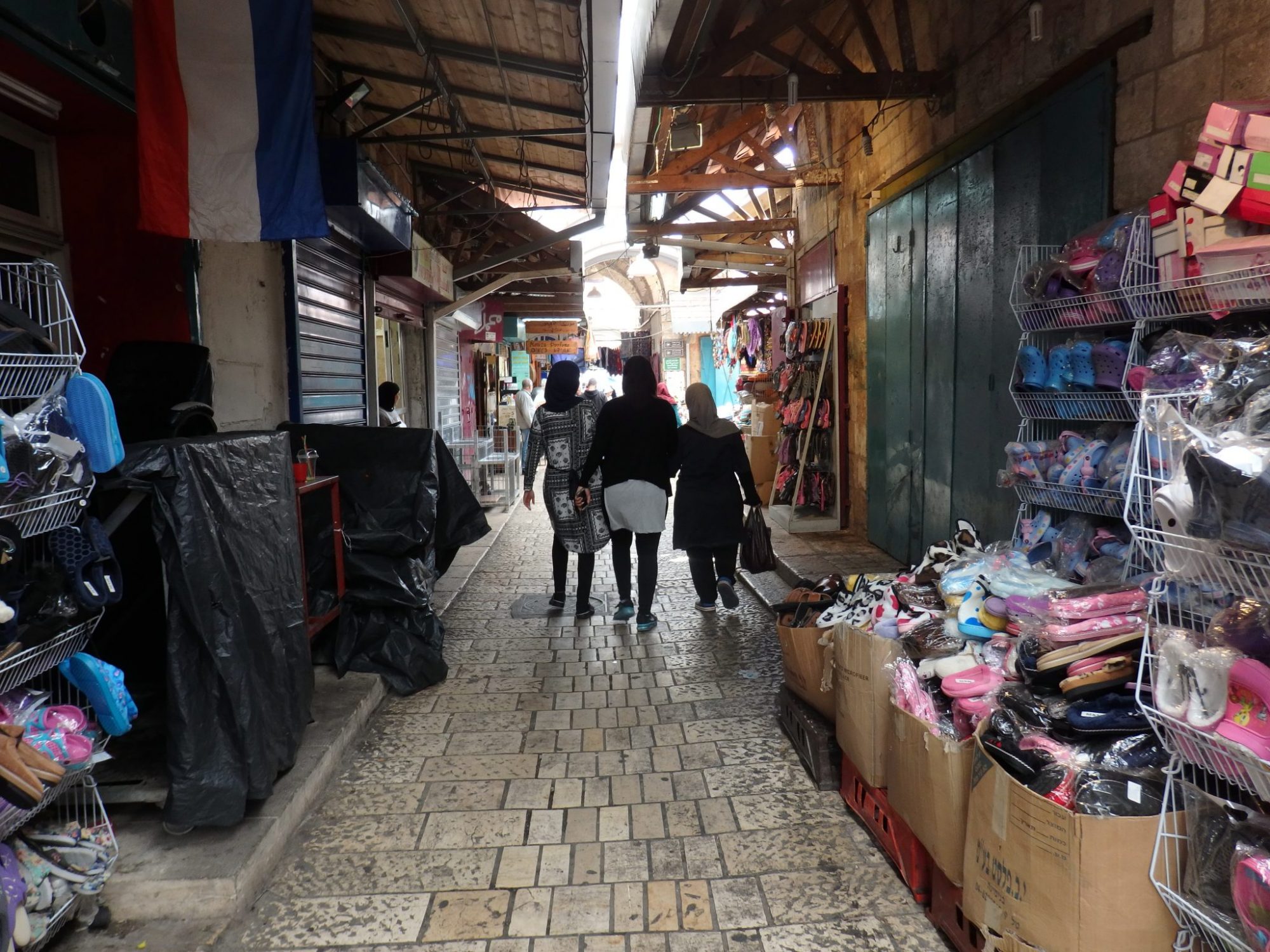
Akko old city, like Jerusalem old city, is home to interesting historical sites covering more than two thousand years.
The main difference, though, is that Akko isn’t a contested city. It’s not home to holy sites crucial to three different world religions. While Jerusalem is a UNESCO World Heritage site (proposed by Jordan rather than Israel), it is also included on UNESCO’s list of World Heritage in Danger.
Akko also has UNESCO World Heritage Site status. When I visited, it just felt a lot less tense than Jerusalem. Akko old city’s population is almost entirely Israeli Arabs these days, so it doesn’t have the uneasy sharing of space that Jerusalemites have to deal with in the crowded streets around the Western Wall and the Dome of the Rock.
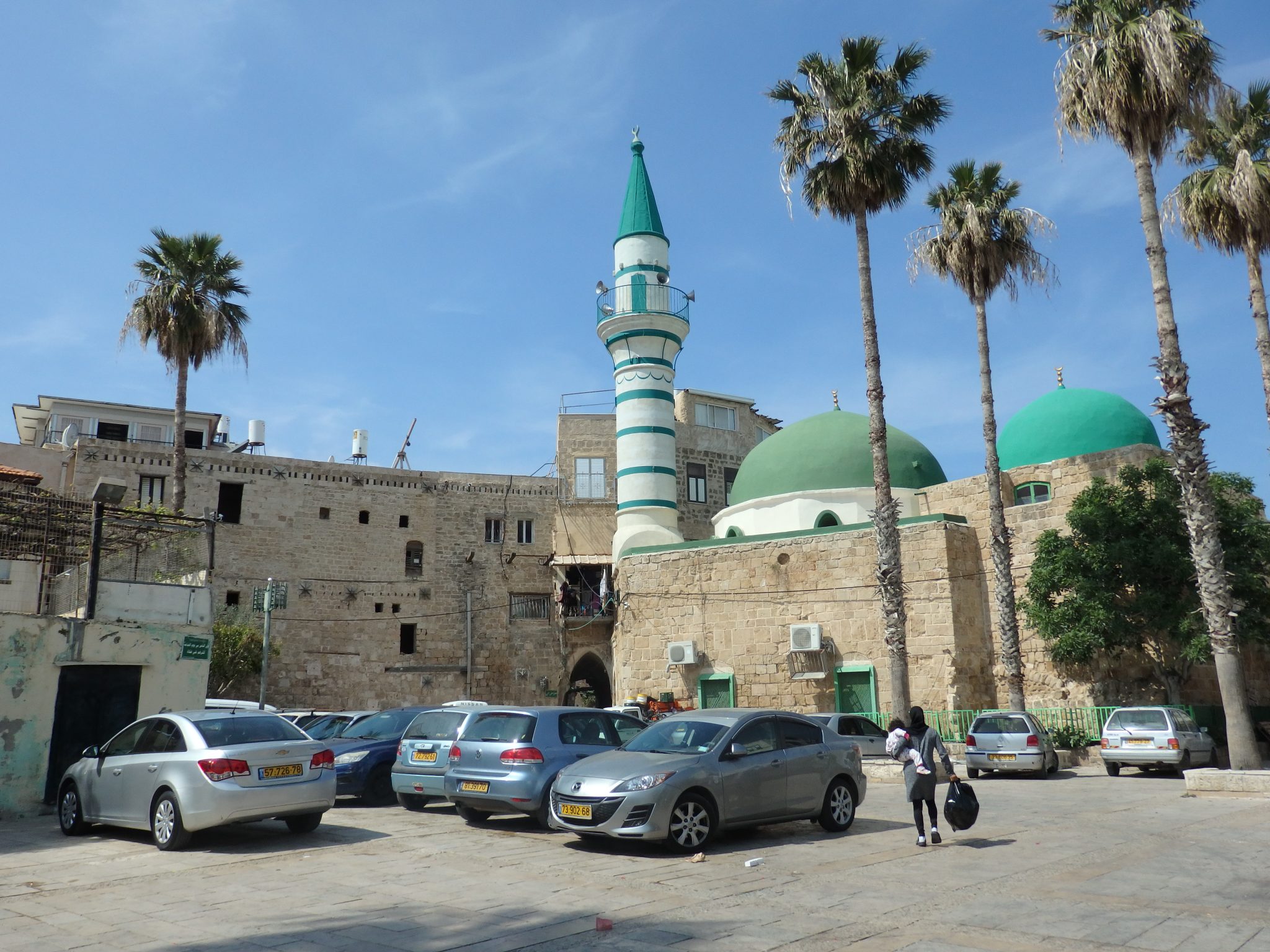
Note added October 2024: This assessment, first published in 2017, isn’t quite correct anymore, with Hezbollah lobbing missiles into northern Israel, including the city of Akko. It’s not a good time to visit right now, but since people seem to be reading this article more, I thought I should update it anyway. It’s worth pointing out too that the city’s population is about one-third Israeli Arabs, with an even higher percentage in the old city.
History of Akko old city
Akko’s history goes back about 4000 years. It was conquered by Tutankhamen of Egypt, for example, and the Assyrians (701 BCE) and Alexander the Great (333 BCE). The Romans killed 2000 Jews in Akko during the Great Revolt in 66-68 CE.
The biggest draw for tourists today in Akko old city is its history as a Crusader port city. Akko was conquered in the First Crusade in 1104, and used as the main port for the crusaders heading for Jerusalem. The crusaders ruled Akko until 1187, when it was taken by Saladin.
The Crusader forces under Richard the Lionheart captured it back in 1191 in the Third Crusade and held it for a hundred years, until the Mamluks conquered and mostly destroyed the city.
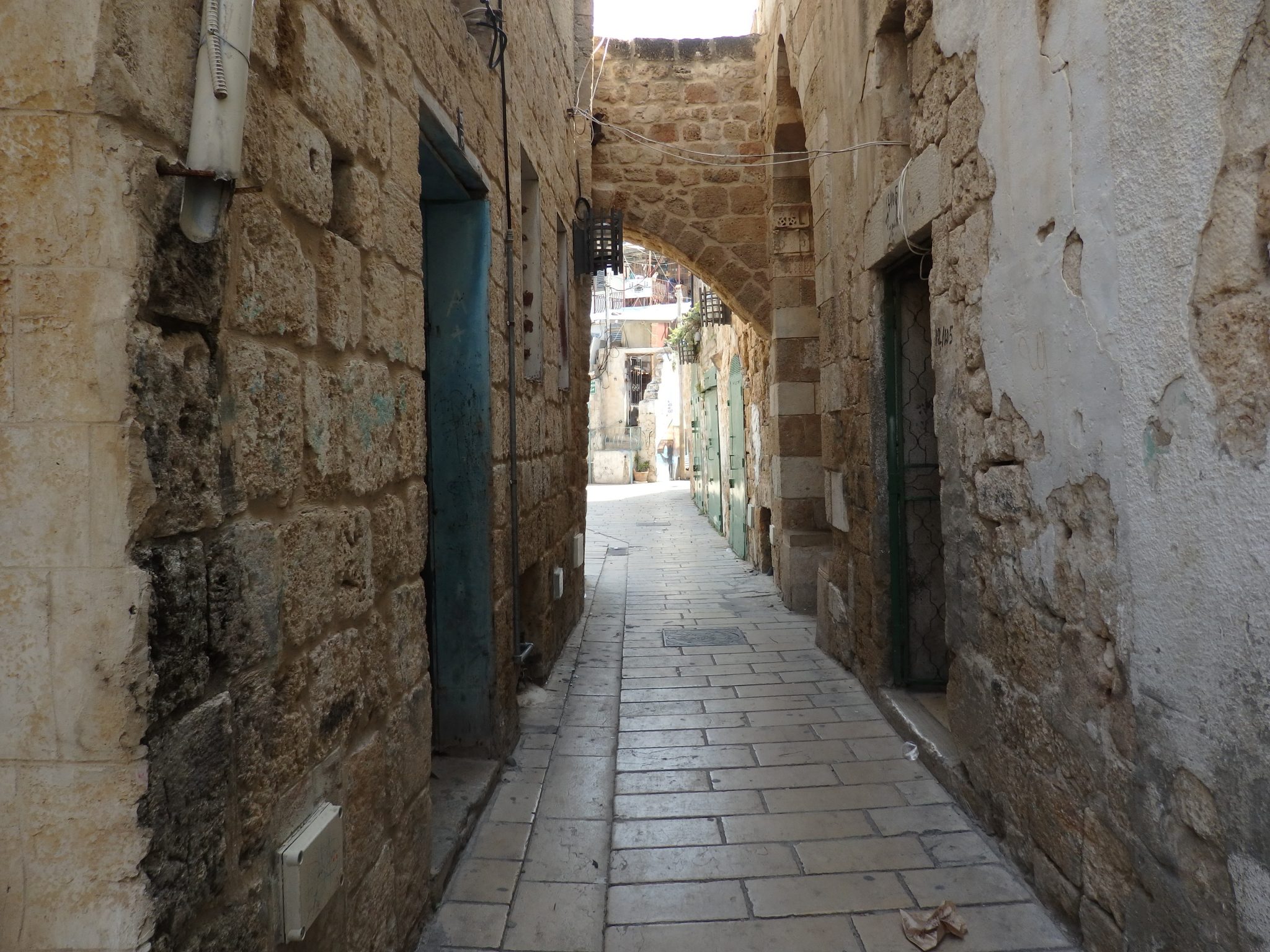
Akko’s renaissance started in the 1700s, under Ottoman rule, which lasted until the British took it over from the Turks in 1918.
The Hospitaller Fortress
After the 1191 reconquest, the Knights Hospitaller, a military and religious order, built a new fortress to be their headquarters, since at this time the Crusaders no longer controlled Jerusalem. Later, in the Ottoman period, a citadel was built on the same spot, using the ruins of the Knights Hospitaller’s fortress as its foundation.
Starting in the 1950s, and mostly taking place in the 1990s, the original medieval fortress has been uncovered and restored, while also preserving the Ottoman citadel above it.
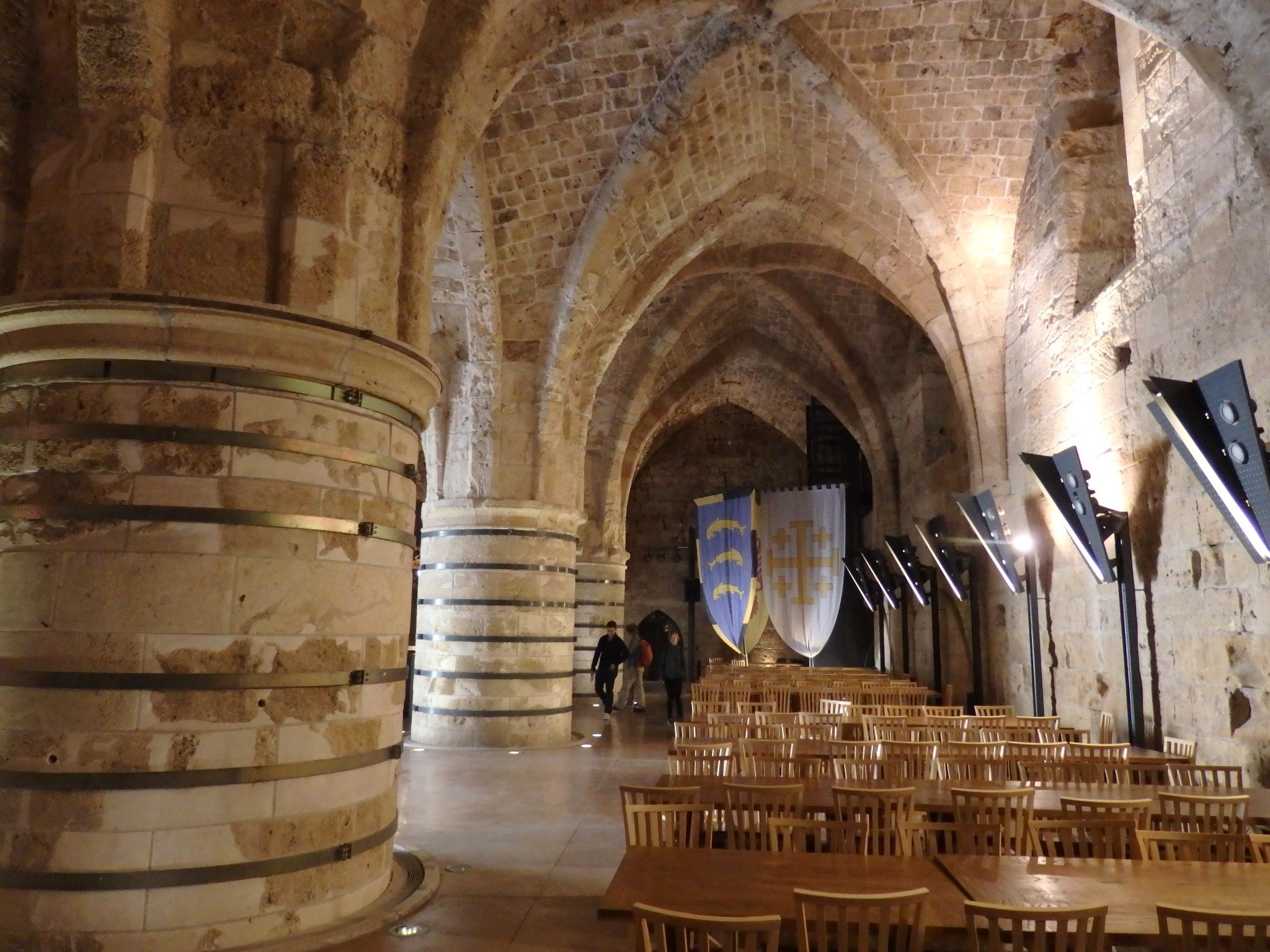
This is why it’s sometimes called “the underground city.” The fortress had courtyards and streets, open to the sky. Today they are topped by the newer citadel above. In other words, what was once outside is now inside, making it a strange space to explore. A sign might say you are walking on a street, but it is actually inside, and the lighting in general is rather dark.
The fortress is a maze of halls, courtyards and “streets.” On first entering, a series of signs, each accompanied by just a few well-lit artifacts, explains the long history of Akko. Multi-media exhibits here and there help visitors imagine how people used the spaces inside the fortress.
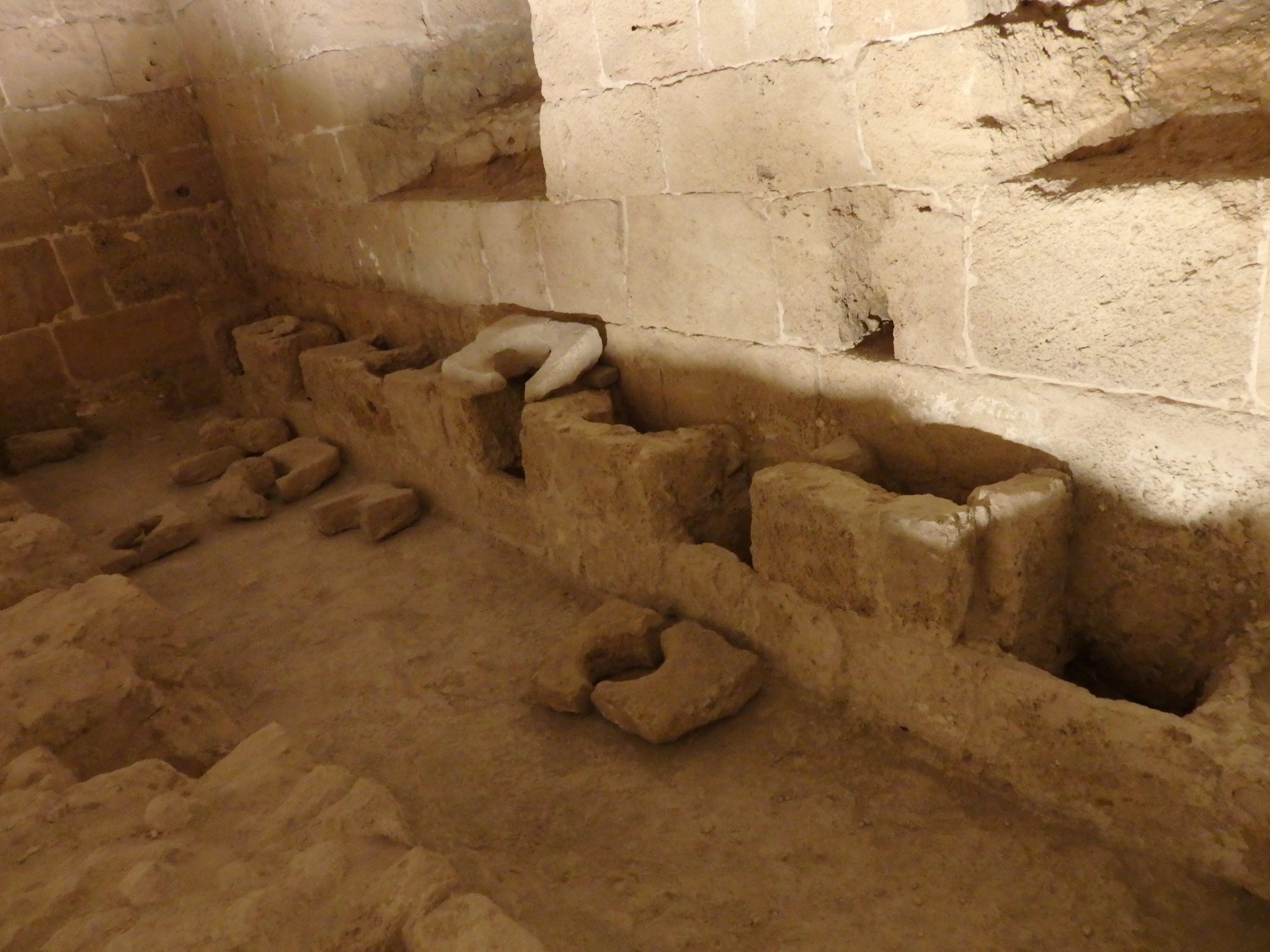
For visitors, though, this is mostly about the architecture. Those Knights Hospitallers knew how to make a grand impression with their architecture. Some parts of the fortress have rounded Romanesque vaulting, while others sport elegant gothic cross-vault ceilings supported by massive pillars. All of it is dramatically lit, making it feel almost spooky.
The Templar Tunnel
The Knights Hospitaller took it as their duty to help other crusaders. Pilgrims streamed into the Holy Land in the hundred years that the crusaders controlled Akko. Their original fortress stood on the southwestern edge of the city, where you can still see its foundations when the water is shallow. The port, where the pilgrims arrived, was on the east side of the city. To connect the fortress to the port, the Knights built a tunnel, 350 meters (1,148 feet) long.
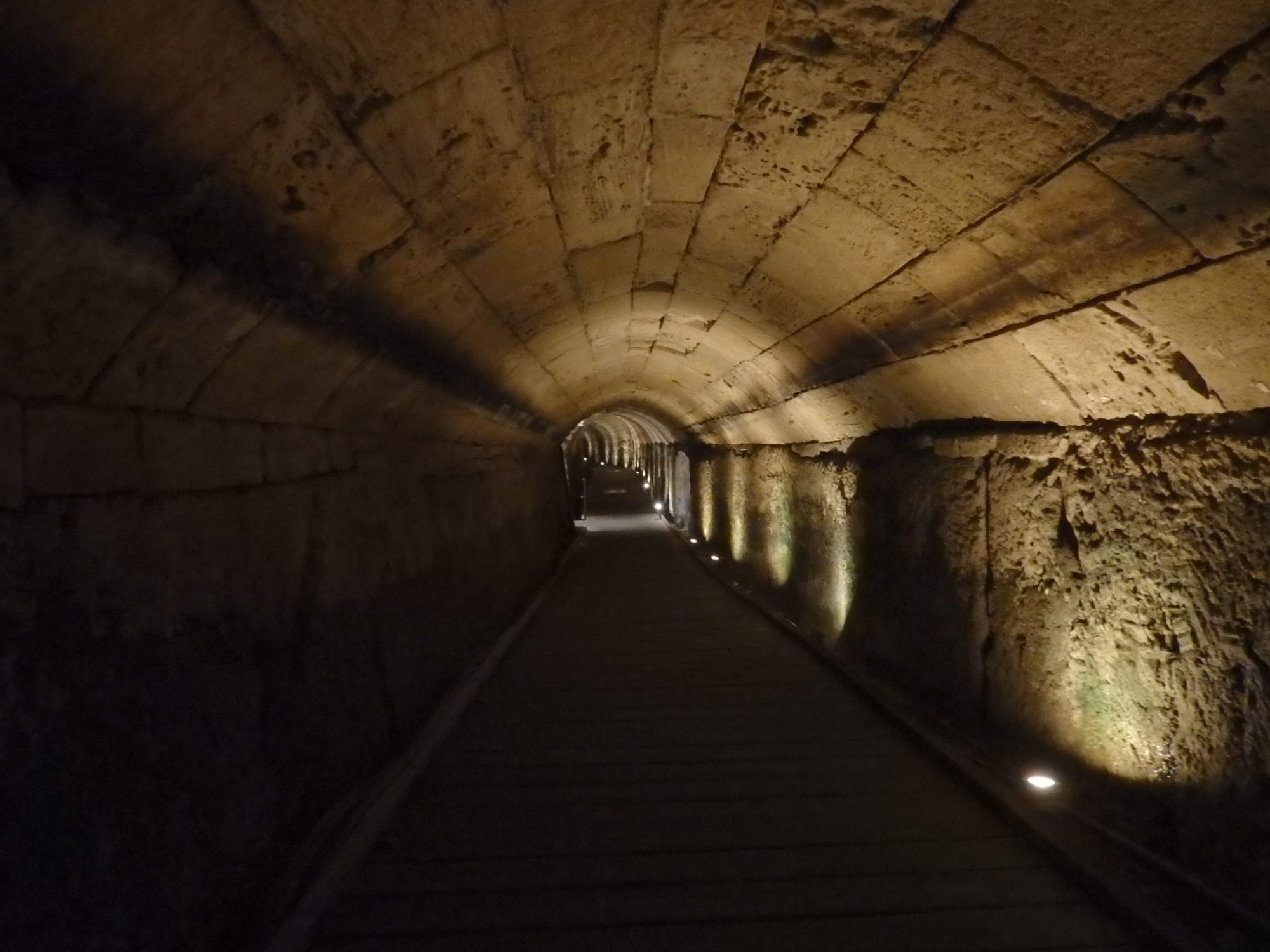
Walking through it, entirely alone, I was surprised at the sheer size of the tunnel. I had been expecting something like the one I walked through at the City of David in Jerusalem: narrow and dark, forcing me to duck at times. This tunnel? The pilgrims and knights could have walked through three abreast with no problem, and I’m pretty sure a knight on a horse would have been able to travel this way as well.
Today, the tunnel has a wooden walkway, allowing visitors an easy walk and dry feet. Apparently, the bottom half of the tunnel was cut from the bedrock. The upper half is cut stone.
The Turkish Bathhouse
Leaving the Crusader period, the Turkish Bathhouse is an interesting, if somewhat cheesy, stop. Rather than just letting visitors tour the 18th-century structure, the owners treated us to an “experience” involving a video of a fictional “last bath attendant” swapping stories with the bath attendants who served before him.
I could have done without the contrived presentation, especially since it malfunctioned at one point, making us sit through the film twice.
Nevertheless, the building itself is graceful with domed ceilings letting in dappled light through a pattern of cut holes. Statues show what it might have looked like in use.
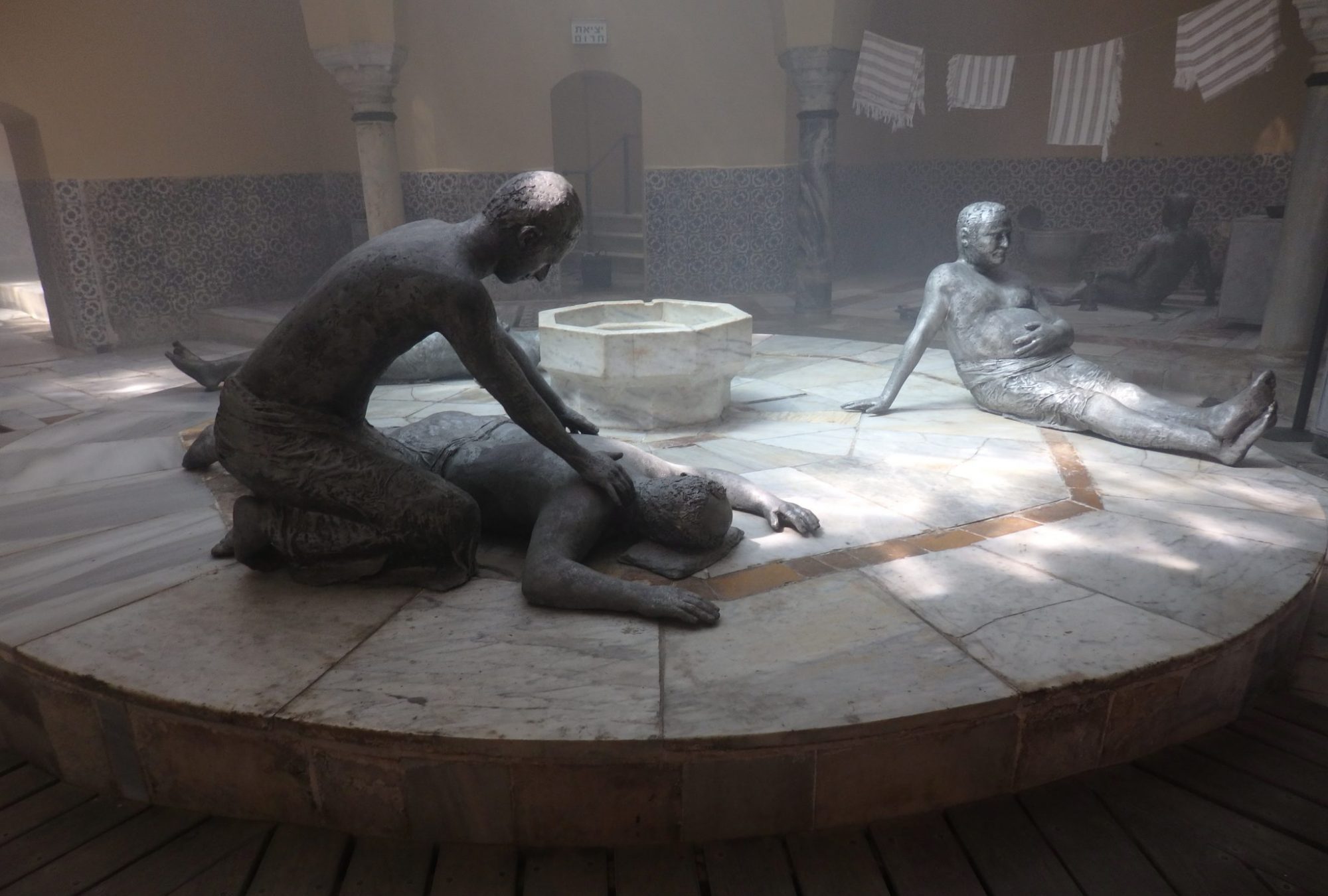
Other points of interest in Akko old city
The Enchanted Garden
A pretty oasis of green, the Enchanted Garden is likely to be your first stop. The visitor’s center is here, as is the ticket booth where you can choose which places you want to see and buy a combination ticket. Don’t waste your time on the introductory film at the visitor’s center; it’s a publicity film for Akko, so you won’t learn anything from it.
Akko old city walls
The Akko old city walls are still mostly intact, except where the British cut through to allow cars to enter. You can walk on them for the views: parts of it follow the shoreline, so you can enjoy the beauty of the Mediterranean Sea and the cooling sea breeze. You might also catch sight of kids jumping into the sea from ridiculous heights.
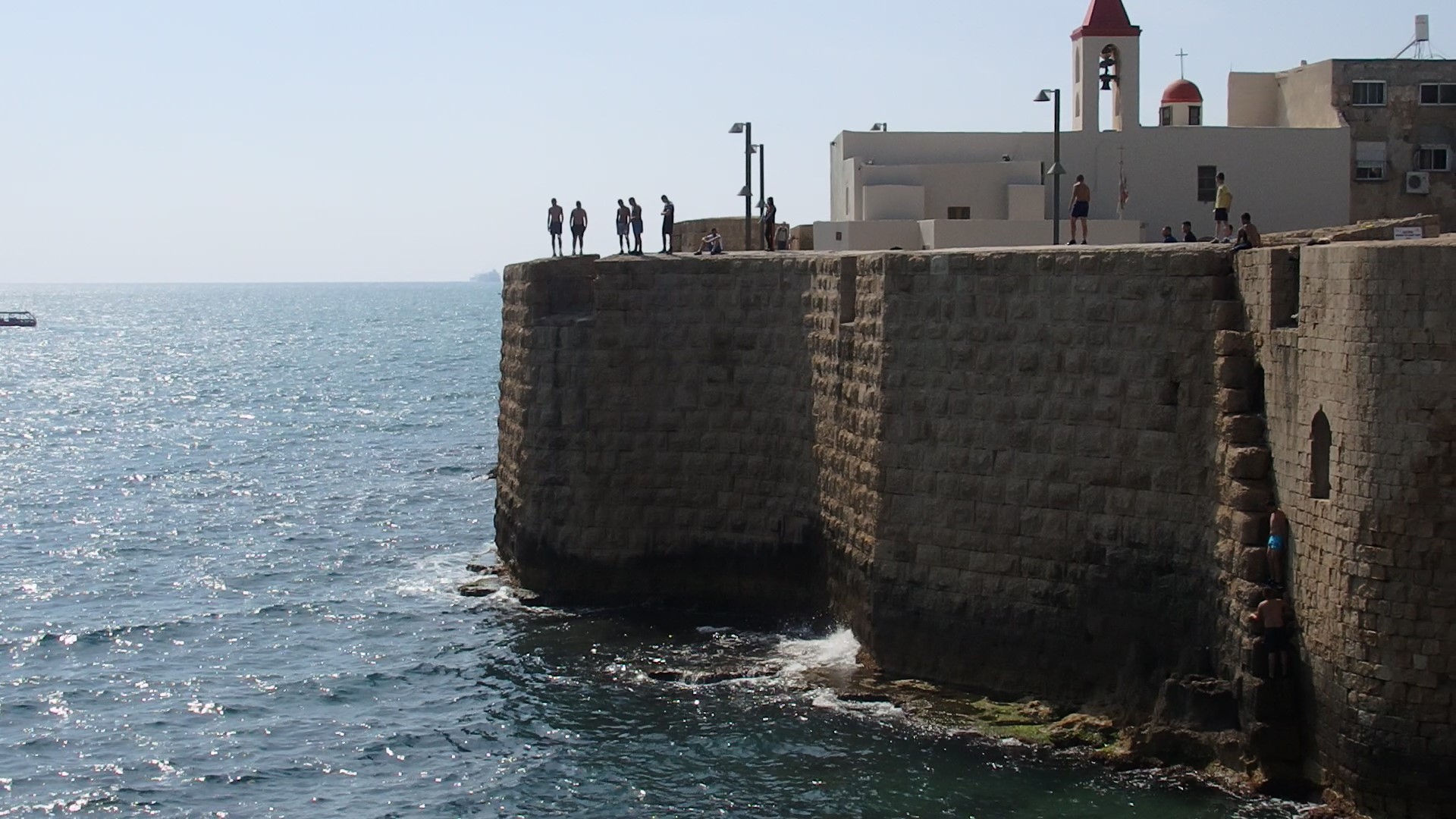
Away from the water, the wall is more embankment than wall, and a second outer wall parallels it, defining a large moat below. These walls successfully held off a siege led by Napoleon in 1799.
The Underground Prisoners Museum
The British used the Akko Citadel to imprison opponents of British rule like members of the Haganah and Irgun. This museum illustrates who was held here and how they lived.
Khans
“Khan” means hotel or caravanserai. Ottoman-period merchants would come into port and need a place to stay, as well as a storeroom for their merchandise. In these khans, they would use the ground floor as a storeroom and the upstairs as lodgings. Several former khans still stand in Akko old city.
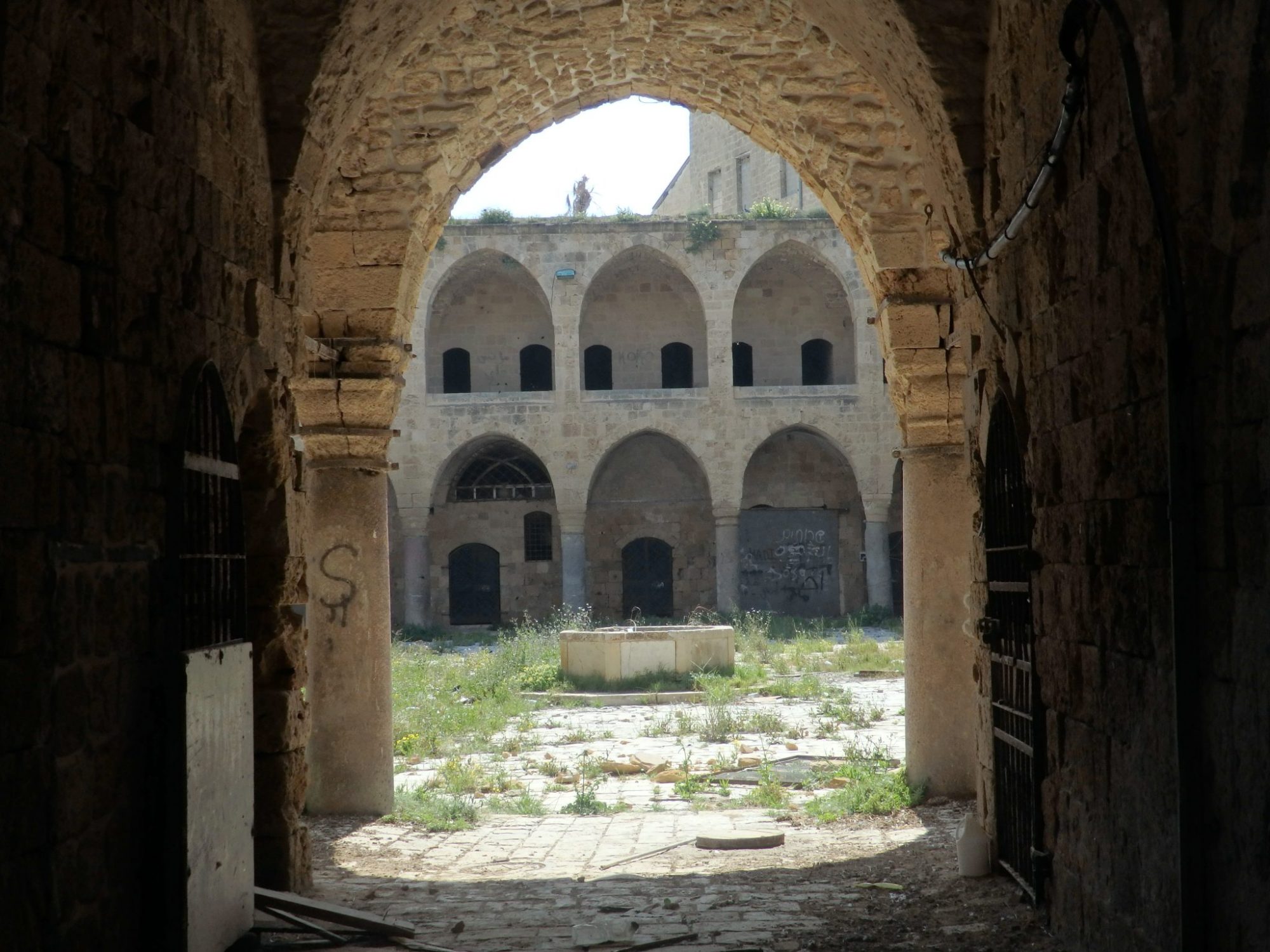
Mosques and markets
Several mosques from the Ottoman period are still in use. The biggest is Al-Jazzar Mosque, dating from 1781.
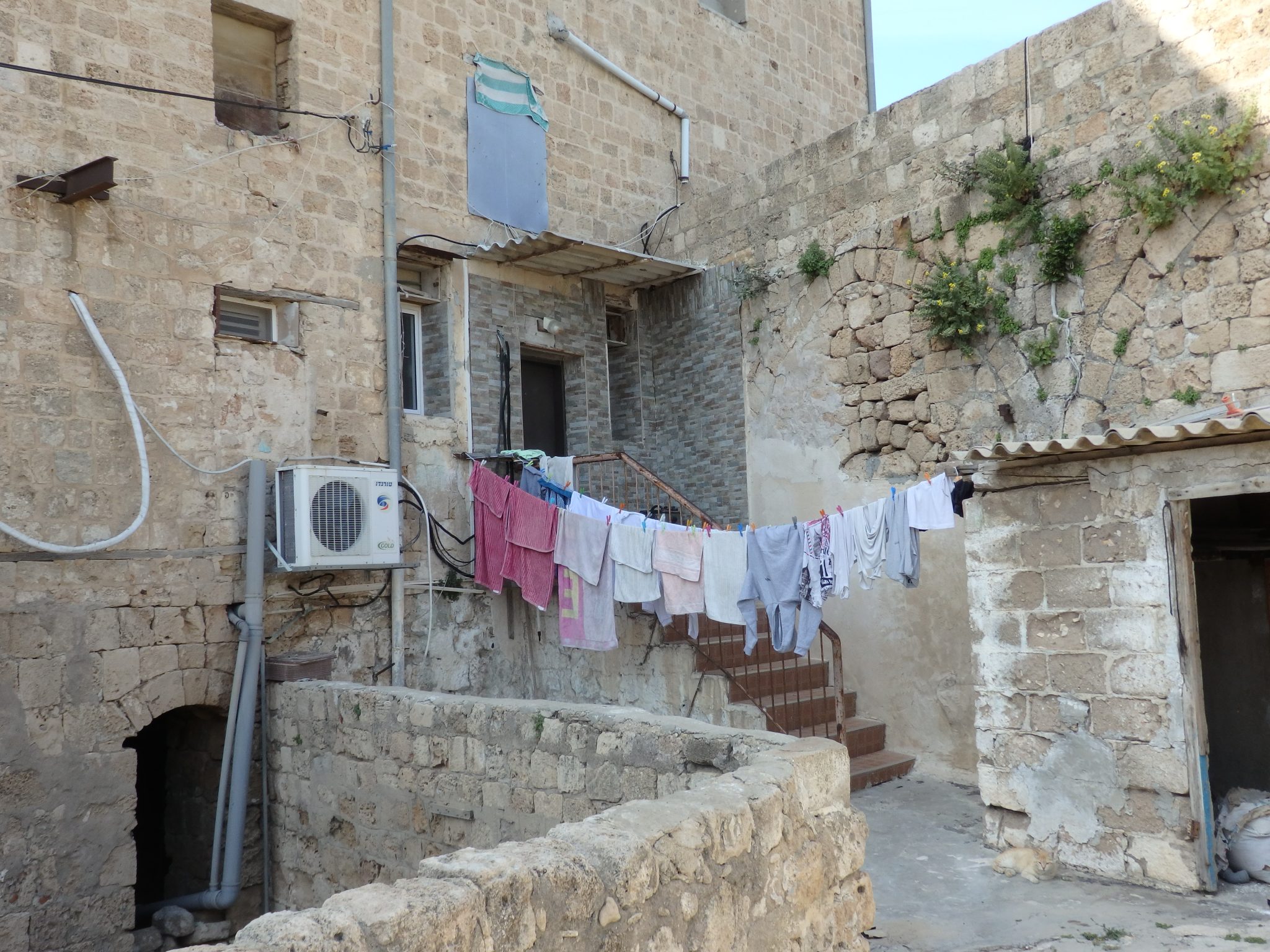
Don’t even try to follow a map around the markets and streets; it’s hopeless. Just take a stroll and see what you find. If you’ve already explored Jerusalem Old City, you’ll see what I mean about this being Jerusalem without the politics.
That’s what it is. Just a small old city, where its residents go about their business, and a tourist industry hopes to thrive.
Have you been to Akko and/or Jerusalem? What did you think?
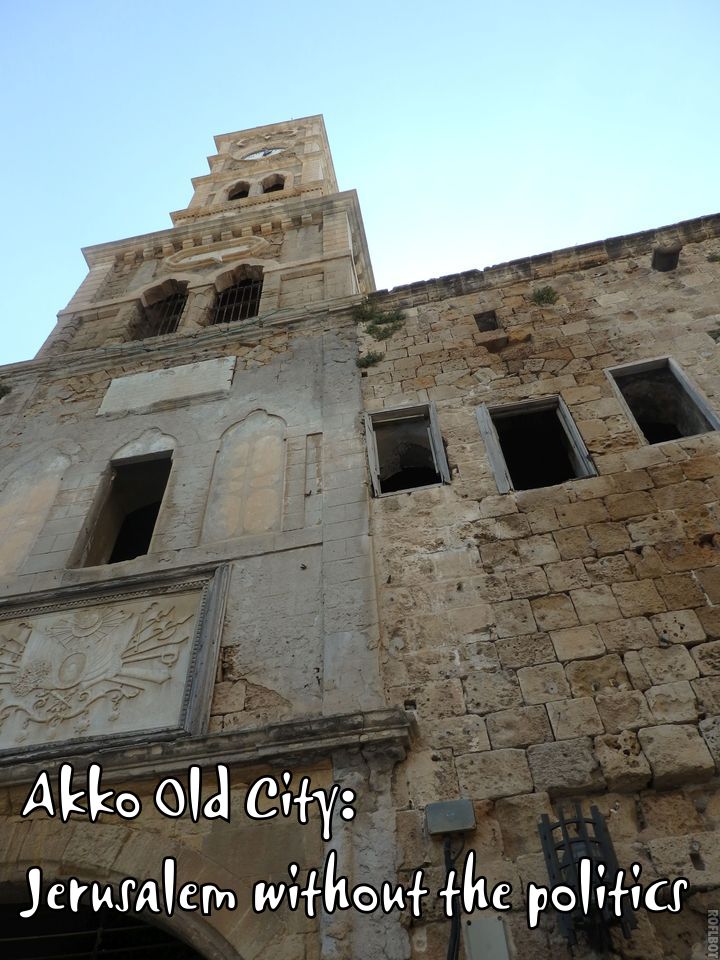
My travel recommendations
Planning travel
- Skyscanner is where I always start my flight searches.
- Booking.com is the company I use most for finding accommodations. If you prefer, Expedia offers more or less the same.
- Discover Cars offers an easy way to compare prices from all of the major car-rental companies in one place.
- Use Viator or GetYourGuide to find walking tours, day tours, airport pickups, city cards, tickets and whatever else you need at your destination.
- Bookmundi is great when you’re looking for a longer tour of a few days to a few weeks, private or with a group, pretty much anywhere in the world. Lots of different tour companies list their tours here, so you can comparison shop.
- GetTransfer is the place to book your airport-to-hotel transfers (and vice-versa). It’s so reassuring to have this all set up and paid for ahead of time, rather than having to make decisions after a long, tiring flight!
- Buy a GoCity Pass when you’re planning to do a lot of sightseeing on a city trip. It can save you a lot on admissions to museums and other attractions in big cities like New York and Amsterdam.
- Ferryhopper is a convenient way to book ferries ahead of time. They cover ferry bookings in 33 different countries at last count.
Other travel-related items
- It’s really awkward to have to rely on WIFI when you travel overseas. I’ve tried several e-sim cards, and GigSky’s e-sim was the one that was easiest to activate and use. You buy it through their app and activate it when you need it. Use the code RACHEL10 to get a 10% discount!
- Another option I just recently tried for the first time is a portable wifi modem by WifiCandy. It supports up to 8 devices and you just carry it along in your pocket or bag! If you’re traveling with a family or group, it might end up cheaper to use than an e-sim. Use the code RACHELSRUMINATIONS for a 10% discount.
- I’m a fan of SCOTTeVEST’s jackets and vests because when I wear one, I don’t have to carry a handbag. I feel like all my stuff is safer when I travel because it’s in inside pockets close to my body.
- I use ExpressVPN on my phone and laptop when I travel. It keeps me safe from hackers when I use public or hotel wifi.



I think Akko looks great and ticks off all my boxes of what a historical city should be.
Yes, an Arab mob just tried to lynch 2 Jewish teens that were fishing. Wonderful place to visit, same as Jerusalem where Jews are murdered weekly.
So are you saying that tourists shouldn’t go to Israel at all? Or that it’s okay to visit if you’re not Jewish? I’m not going to get into the politics of visiting Israel here; I wrote a couple articles about it back in 2014 or so: Tit for tat: The American version (https://rachelsruminations.com/tit-for-tat/) and Why I”m in Israel (https://rachelsruminations.com/why-im-in-israel/). Every traveler has to make that decision themselves: where to draw the line in terms of risk they want to take themselves and what countries they decide not to visit for political reasons.